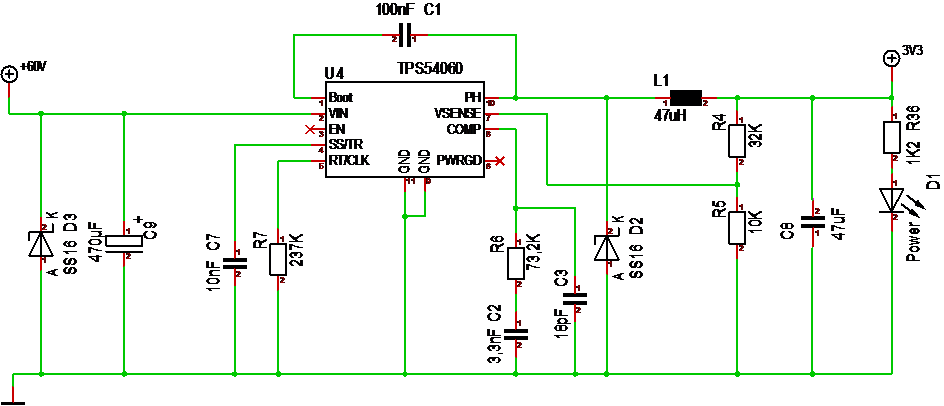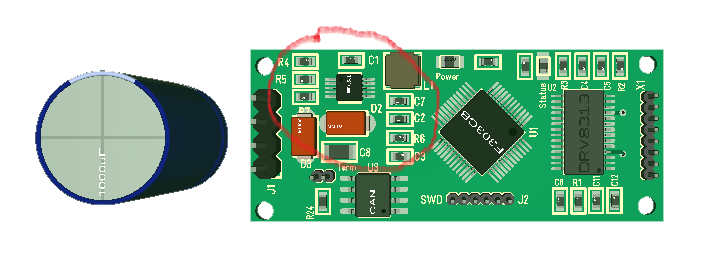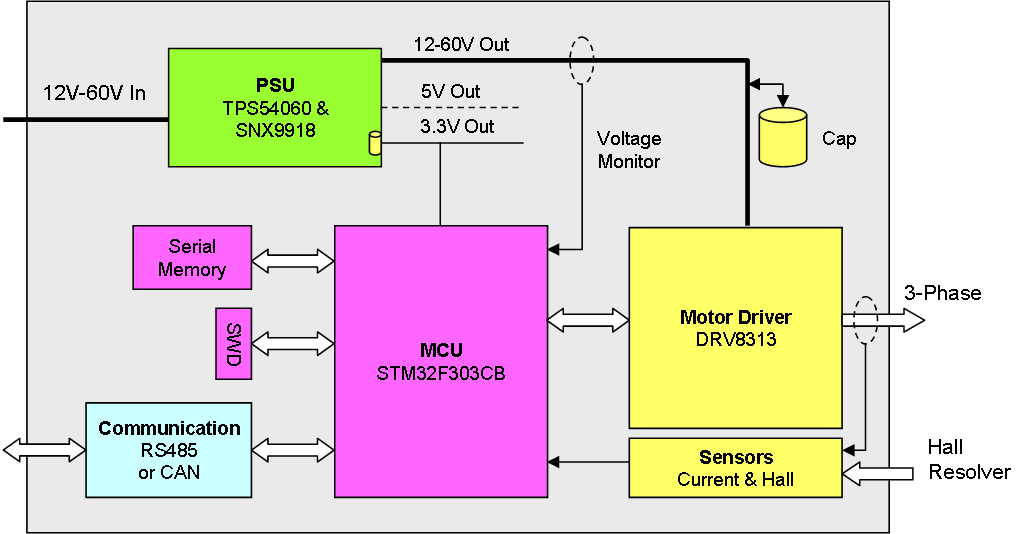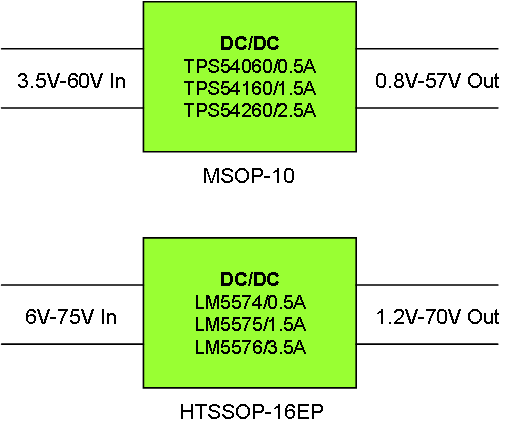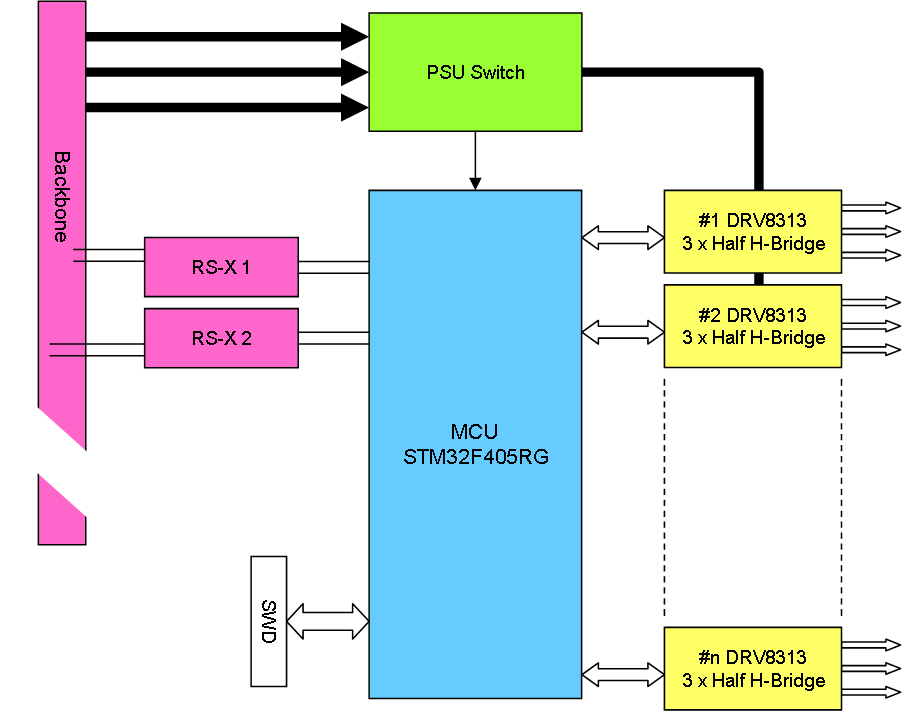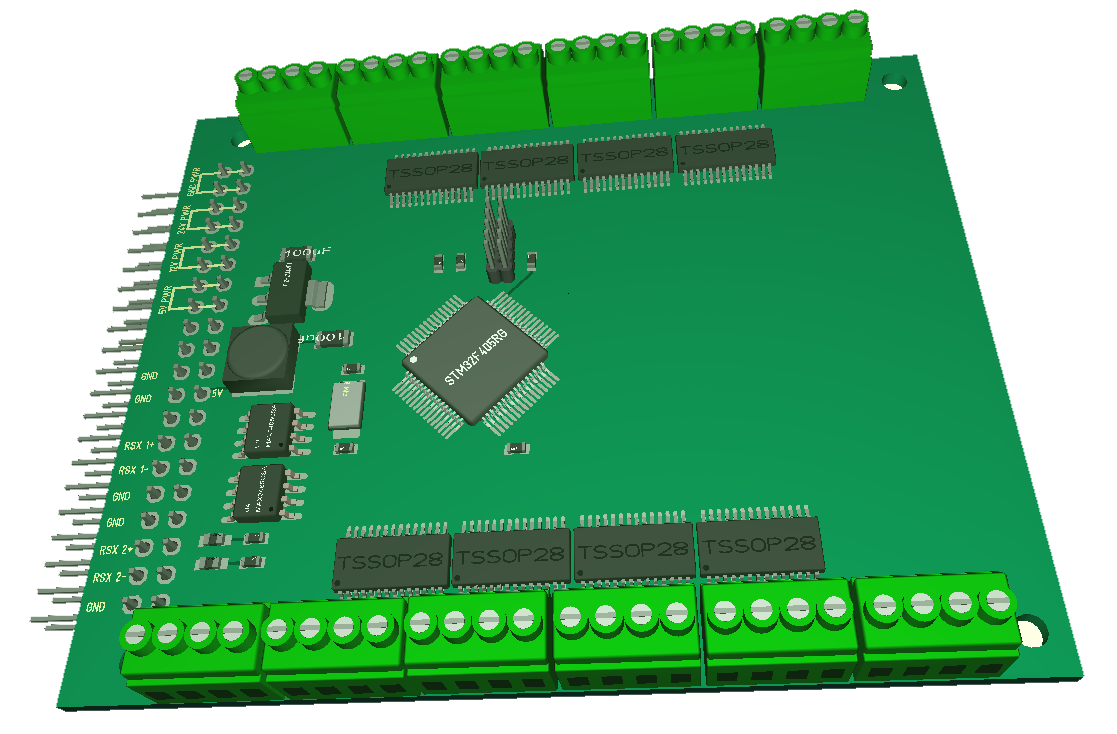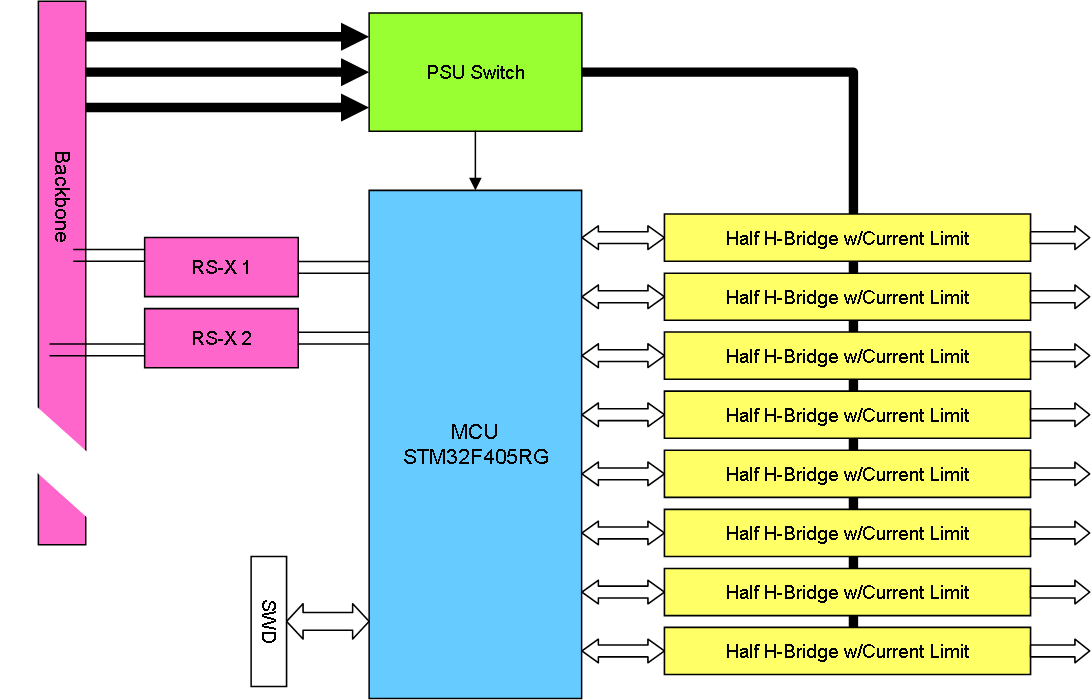This module took me by surprise. I thought I had ordered a 5V to 5V isolation module, but realized it is a 240V AC to 5V/1A full PSU unit in a box that is 38mm x 22mm and 18mm height costing 3.6 USD or similar. I actually have a project that need something like this, so this came very handy.
60V to 3.3V DC/DC
This is my first attempt on a 60V to 3.3V DC/DC converter. I am using the reference diagram for TPS54060 with a few modifications.
Starting at left I use a SS16 Shotky diode + a 1000uF since this is for a motor driver. You can otherwise use far less capacitance on the input. I left EN and PWRGD floating – EN is used to set under voltage shut down, while PWRGD signal if there is an error. L1 and C8 is the PWM filter and at right you have a standard Led to indicate power. C7,R7,C2,R6 and C3 are just from the reference diagram. Their values impact things like switching frequency. I need to read the datasheet properly and doublecheck with what others have done, so I can’t guarantee that this will work – but, we can give it a try!
This 3D model is the first attempt of routing a simple version of a DRV8313 60V BLDC Controller. This board is 50 x 20 mm, so it is really small and you can see the DC/DC in the red circle. I drew the 1000uF on the outside because it will be mounted as an extension fo the board. I also decided to use a coil at the size of 2x 1206 package. I should mention that all components here are on top-side. I will return to the BLDC controller itself later. This is DRV8313 With hall sensors only. This is a simpler design than the one I mentioned earlier as it lack the super-cap, current sensors and Serial memory, but it still have hall sensors. Looking at the density of the Board I probably need to extend the length a few mm as I finish it – lets see. To add the missing features I probably need another 2 cm – not sure.
I was hoping for even smaller Space on the DC/DC, but the number of components and the size of those SS16 diodes drags it up a bit, but draw a square 15 x 15 mm on a paper and you realize how small this actually is – and this is a 60V to 3.3 DC/DC delivering 0.5 to 1A. This design is 0.5A, but I can swap out with TPS54160 to get ca 1A if I need to.
New BLDC Controller
The drawing below illustrate my New, planned DRV8313 based BLDC Controller Design:
This will give a small BLDC Controller capable of 8V to 60V operation with up to 2.5A on 3-Phase motors with or without Hall sensors.
- 8-60V operation
- Perfect for 12V, 24V or 48V systems.
- Up to 2.5A motors
- Sensorless or Hall Sensor driven
- Full FOC support.
- Focus on speed/position control on small motors.
- Drive 3-Phase, DC motor or solenoids.
- RS485 or CAN
- STM32F303 MCU
I use STM32F303CB as MCU because of their build-in programmable Op-Amps that can be connected to ADC input lines. F303 comes in LQFP48 package and is priced < 2.- USD even if it is a M4 ticking at 72Mhz. This is one of the more attractive motor controller MCU’s around. It contains 128Kb Flash and 40Kb SRAM, of which some are CCM and can be used to execute fast code.
Motor Driver will be DRV8313 that is popular on various Gimbal drivers. This allow individual Half H-Bridge driving, so it is basically just a chip with Gate Drivers, MOSFET’s and a bit of logic. It is possible to add 3 individual current sensors. Each channel can be controlled separately, meaning we can drive a 3-phase motor, DC motor or 3 x solenoid’s. But, the focus is small Brushless motors with Hall sensors that need to drive slow.
Sensors are 1 x DC Rail sensor, 3 x current sensors, 3 x Hall sensors and temperature sensors. The idea is to have 3 separate current sensors to enable sensorless mode and individual channel usage. Current sensors on this consist of a Shunt, a low pass filter and Op-Amps on the MCU itself. Depending on available pins/space I might make available some external IO pins.
Communication is RS485 and/or CAN. I will use a new SWD connector based on 5/6-pin Micro JST.A serial Flash or EEPROM will be evaluated for storing parameters.
PSU will be based on TPS54060 and optionally SNX9918 if we need both 5V and 3.3V. I will try to add 1000-3300uF Caps on the 8-60V directly connected on the board and preferable between the DRV8313 and the rest of the system. I will also attempt to add the 0.33 supercap used on MC4X15A.
The name of this will be MC3X3A. The initial plan is that I will attempt a narrow controller 15mm to 20mm width and 50 to 70mm length., but actual size will be adapted as I go as usual.
As for moving on – I want to test both DRV8313 and TPS54060, so I might give this design a bit priority. I have all the components, but making this design will put my knowledge a bit. Last time I tried DRV8313 I decided to cancel the design. It was the combination of 12V limitation and size as well the plans to move on with STM32F030 and DRV10983. And I still plan to make a new, updated DRV10983 design as well. One step at the time I would also like to move on with much, larger motor controllers at some point.
Miniature 60V to 3.3V DC/DC
I found 2 series of DC/DC converters that can handle 60-75V from TI that also is available from AliExpress showing that they have some popularity. These all cost around 1.2 USD from my sources and are decently small.
These converters consist of a chip with build in MOSFET’s and PWM generator so you basically add the inductive filter and a bit of external components to adjust values. I will end up with 12+/- components on each design. Current limit range from 0.5 to 3.5A on what seems to be pin compatible devices.
Focusing on TPS54060 for now that deliver 0.5A and comes in a very small MSOP-10 package with a Pad on the bottom. I know that some of the 1206 package inductors are rated to ca 200mA and I use one of these on the DRV10983 with success. I was thinking of replacing the AMS1117 on the DRV8313 with this design and minimize size on everything. 200mA is a lot where space does matters due to total size.
60V is quite attractive for BLDC controllers as it makes it very safe to operate 48V. For an actual 60V system I would use the 75V LM5575.
Adding to this I also found a dead cheap linear SO-23 Regulator 16V to 3.3V/500mA (SPX9918). This comes in both 5V and 3.3V versions making it easy to operate with 12V, 5V and 3.3V. I will need 12V for Gate Drivers, but I might also need 5V for some chips.
What I still lack is a low cost/small space isolation DC/DC for 12,5 & 3.3V.
PLC – 24 Channel PWM Driver
This show DRV8313 used as a PWM driver on a PLC Module. This way I can get from 12 to 24 PWM channels with up to 60V @ 2A each. This gives an insane combination of 8 x BLDC Motors, 6 stepper motors, 12 DC Motors and 24 Solenoids. I need to think about this one.
In comparison with my previous module with 8 channels this will be limited to 2A, while the other can support far higher currents. But, the reality is that most stuff is below 2A and this is far more usable (assuming we can put on 6-8 x DRV8313). I do however have a problem with 24 current sensors, so I probably need to install a current sensor on the board or one per DRV8313 – lets see. I am not sure I want to make this module, but I admit that it is very tempting.
Just a quick mockup of a PCB with main components and possible connectors just to illustrate that this is very possible. Another option is that I add 12 PWM channels at top and 16 or so Analogue channels at bottom on a combined card.
Upgraded Micro BLDC Controllers
If you search for schematics you will notice that DRV8313 is far more popular than DRV10983. DRV10983 only support 28V, while DRV8313 support 60V, but the most important difference is that DRV10983 needs to be programmed through I2C while DRV8313 have direct PWM per half H-Bridge.
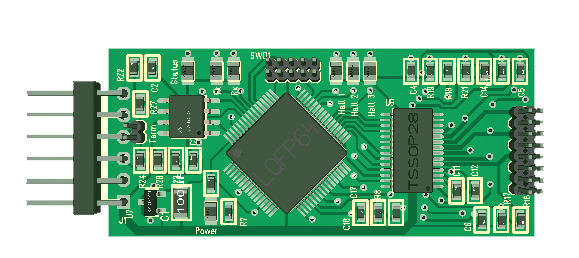
The 3D model above show the DRV8301 based design using a STF32F105RB, while the DRV10983 using STM32F030F4 is shown below. The size of the the driver above is 50 x 20 mm, while the one below is 40 x 11 mm.
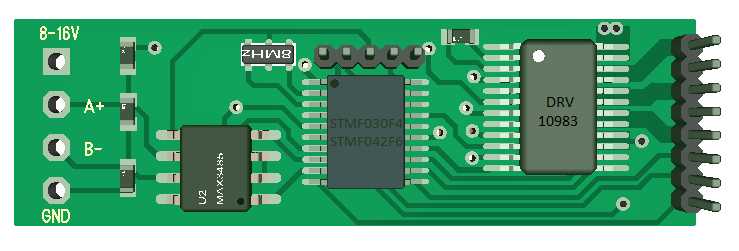
I initially started with DRV8313, but switched to the simpler DRV10983 which is working “ok” and support a very small size. I needed 9mm more to route DRV8313, but I also supported far more on the DRV8313 design and used a LQFP64 MCU package.
I never put the DRV8313 design into test, but I actually have a load of chips and want to make a new design based on this. I like the 60V capability and the capability to use the MCU to drive the motor, I also have loads of STM32F303CB MCU’s that cost < 2.- USD and is very optional as a Motor Controller.
Both these designs have a 2.5A limitation, but the cost of DRV8313 is ca 50% of DRV10983. I will continue both designs as I also plan an upgrade of the DRV10983. I do however need to get going on coding the I2C on this and convince myself that I can control the motor speed a bit better. Next PCB will also be simpler as I am replacing connectors and removing the separate PSU.
One huge advantage on DRV10983 is the 100mA 3.3V DC/DC converter. DRV8313 only support 10mA and that is to low for a MCU + Tranceiver, meaning that I will need to find a different PSU solution. I need a 60/3.3V DC/DC supporting 100mA. I can easily use LM2596HV that do this at 3A, but that alone will be larger than the controller.
Next focus will be to establish a DRV8313 on a smaller, but decent size, while I try to minimize DRV10983 even further. And believe me, these are small as they are now! The actual target is mA Level motors, so the 2.5A range is very cool.
PLC-PWM Module
This is an old PWM Module drawing. The idea is to create a PLC module that can handle 4,6 or 8 PWM channels with 12/24V and up to 3A. I know from testing of MC4X15A that this is very doable as soon as I solve the current sensor on the channels.
The usage here is to drive solenoids, dc-motors, even stepper motors. An old hydraulic actuator will typically be driven by 2 x 24V PWM signals pulsing at very slow rates using ca 1A per channel. And yes, I can drive 2 x 3 phase motors as well since I will be using the 2 Advanced timers With 4 PWM channels each. Using the same design as on MC4X15A I actually have an option for higher currents, but this needs to come from a singlle PSU Source and I believe a max rating of 10A in total is reasonable and doable. For higher currents we need to consider specialized designs.
I have a few advantages compared to the motor controller as I have no usage of the BEMF signal and “only” need 8 PWM signals and 8 ADC signals as interface. IR2103 can combine H&L since L input is inverted and as such be driven by a single PWM pulse. I am, not able to offer 5V PWM since the gate drivers and MOSFET design requires a minimum of 10-12V to work.
Another advantage is that 12 & 24V is provided directly on the backbone, so I don’t need any PSU logic on the Board (except a bit of protection logic). I need to look into routing Power from the backbone to the MOSFET’s and I need to squeeze each channel into 40mm x 6mm to achieve 8. But, it’s no disaster if I reduce to 4 channels. In fact I actually consider making the PWM channel an click-on sub-board – not sure.
I will start on this as soon as I have a solution to current sensing that I like. The advantage with the PLC is that we also have 5V available and loads of the attractive sensor chips need 5V. One I would like to test is MAX9918 because it can handle -20 – +75 Voltage making it attractive for a 60V BLDC Controller later. But, I have not given up on the INA210, INA213, INA214 family yet. The INA family is ranged 26V so they are attractive for a 24V design. Their size is a pain in manual assembling, but it is a blessing in design – if I can get them to work.
The interesting part here is that we take the driver from a BLDC motor, simplify it and re-use it. The result is a very advanced and capable PWM channel.
INA210 Current Sensing
I just realized that my math around INA210 current sensing is wrong. I have dimensioned based on 15A design which is the average I expect from all 4 channels driving a single motor. Basically the input current. But, output current on a phase will be based on PWM. And if you use 50% duty you need 30A to achieve 15A etc. Simply said I have dimensioned the current sensor for a much, much lower current than I actually need to measure. I should probably switch to INA214 (100x) or even INA213(50x).
Max pulse drain on IRF7862 is 170A, but I need to calculate a decent range and dimension this accordingly.
This does however not expect why IN210 does not work as I tested on very low currents, but getting math correct is a step in the correct direction.
Power MOSFET’s
I have collected a few power MOSFET samples that I will be testing in due time. It exist other MOSFET’s, but these are selected due to a combination of package, cost and performance that make them interesting.
IRFS3107 various packages and is rated 75V @ 160A. It is actually rated 195-230A, but looking at the numbers you see that it is limited to 160A continuously at 100 degC. Pulses can be up to 900A and internal resistance is ca 3mOhm. Price is ca 0.8 USD each. I bought 50x at ca 0.4 USD each that arrived in a plastic bag, so I might have yet another factory reject set. These are interesting because they are quite small PCB mounted.
IRFH5300 is the one I plan to replace IRF7862 with as it has the same size and only 1.4 mOhm internal resistance allowing 32A. I will use this on rev 1.1 of MC4X15A. The primary object is to be able to reach 10-20A without heat-sink, but I will see where I get. This is a 30V limited MOSFET costing ca 0.9 USD.
IRF4368 has a TO-247 package allowing a different heat-sink to be used. It is rated at 75V @ 195A, with a pulse peak of 1280A. Internal resistance is 1.85mOhm making it a very interesting candidate for a larger driver. Again price is ca 0.9 USD.
IRFS7530 is D2PAK with 7 legs and rated at 60V with 240A. Pulses to 1450A and 1.4 mOhm internal resistance. This should be known to many as it also is used in the Vedder ESC design. The cost is ca 2.5 USD each.
I need to get my MC4X15A working properly before I continue With larger designs and as mentioned I already have sufficient juice on this for quite large motors. What I actually lack is working current sensors and a solution to support 48-60ich Volt.
5A reached on Motor Driver
Not so much to write home about, but adding the heat sink back on I turned it up to 5A on a single channel – no heat noticed. My new loads do their job consuming some 100W, but my 5A PSU reached it’s limit. This was 20% duty cycle, so actual phase current was 25A. I tried a 2nd channel, but I struggle to find HEXFET’s that work so I am looking forward to get a proper batch in a few weeks time.
This leaves the challenge of the current sensor. I will try a few more of the INA210 and see if I get anything out of them. I will also remove the low pass filter I added after the amplifier to test. One of the challenges with INA210 is that this limits the driver to 26V, At 30V the MOSFET’s become the limit, so this is basically a 24V design.
As for the MOSFET’s. These are rated 30V @ 17A and seems to cost ca 0.8 USD each. At that price I can as well change to the ones that is rated 30A. They cost a little more, but will use up ca half the heat dissipation.

